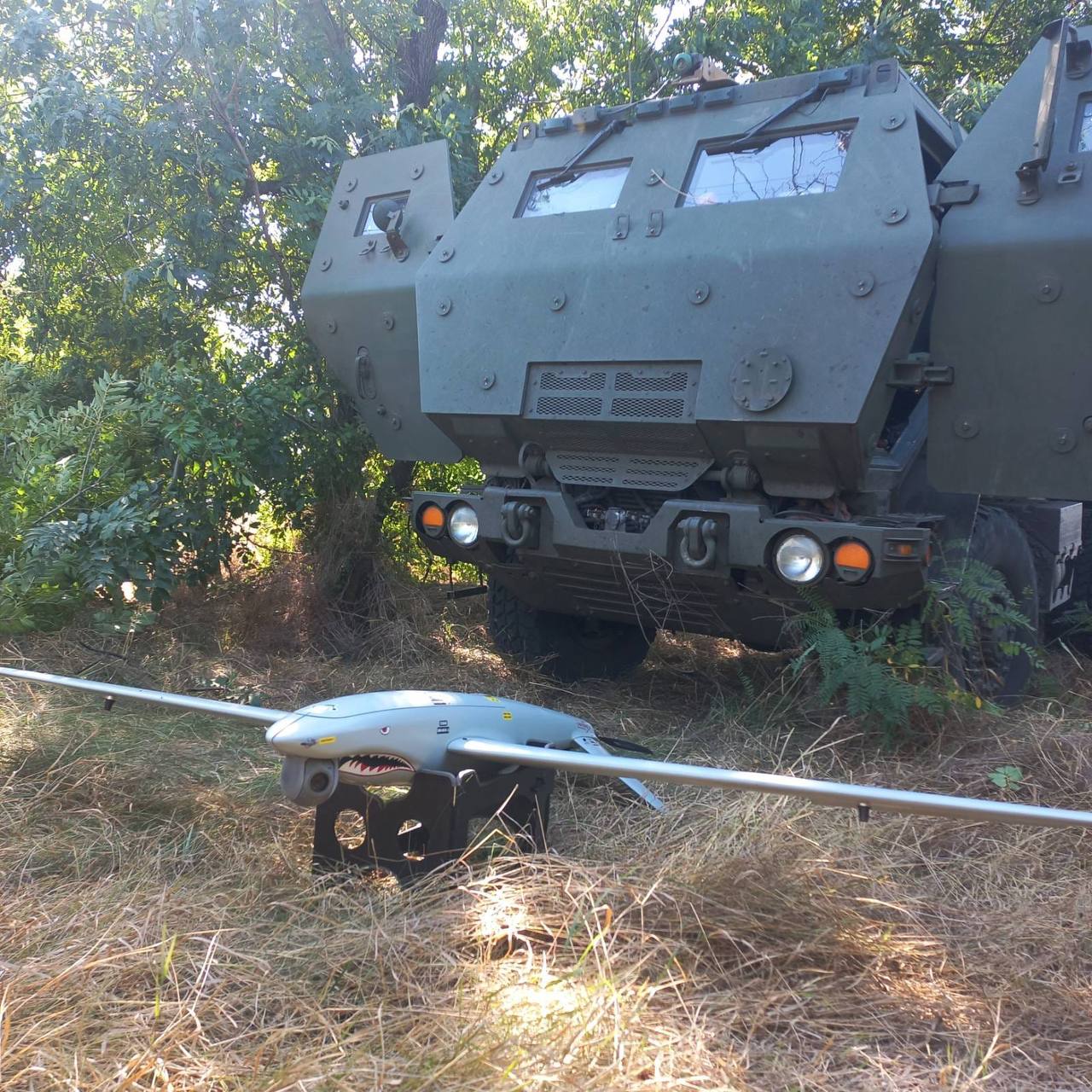A photo circulating on Ukrainian and Russian social media showed the former’s Shark Unmanned Aerial Vehicle (UAV) in front of the High Mobility Artillery Rocket System (HIMARS), giving pictorial evidence to the long-speculated pairing between the two systems.
Ukraine and Russia have used civilian and slightly advanced military UAVs for basic battlefield tasks like reconnaissance, surveillance, and artillery fire correction.
In one of Ukraine’s indigenous UAV systems, the presence of a drone to improve the accuracy of tube rockets and gun artillery has led to limited success. Russia has lost some air defense systems, rocket artillery like the TOS-1A, and heavy mortars like the 203 mm Tyulpan over the last three months.
Pictures Show Shark Before HIMARS
The HIMARS, however, remains just a support weapon, unable to deliver the sweeping battlefield impact promised when Ukraine acquired it from the US. Nevertheless, with Washington continuing to arm Ukraine and showing no signs of ending its support, the HIMARS-Shark pairing might attain some notable gains, especially when placed in the overall scheme of Ukraine’s new emerging doctrine against Russia’s defensive lines.
The photos showed the Shark drone before a HIMARS truck at an unidentified location, placed on a mount. The rotating electro-optical turret under the drone’s nose is turned left.
One handle that posted the photo on X (formerly Twitter) said, “The combination of the two is extremely lethal for the Russians…It’s going to get much worse thanks to ATACMS.”
Has Made HIMARS Effective, Not Game-Changing
Claims about the Shark-HIMARS pairing first appeared in reports in mid-September. They featured videos showing five Russian Buk SAM systems being hit by what was claimed to be hit by HIMARS rockets.
The overhead videos of the missiles being hit are claimed to be shot by the Shark drone in the Zaporozhye (Zaporizhzhia) region. Ironically, the Buk SAMs also intercept and destroy HIMARS rockers in flight.

A report in Business Insider said the Ukrainian non-profit firm Return Alive bought two Shark drones for the country’s Department of Intelligence. It quoted a Telegram post from the department saying that the “gifted Shark drones would be used for spotting targets for HIMARS.”
It is unknown if the HIMARS used by Ukraine were firing their rockets entirely without the assistance of drones, but that largely seems to be the case. Moreover, with only two Shark systems being purchased, the reports imply that the rest of Ukraine’s HIMARS platforms (its only tube rocket artillery system) do not have drones.
An entire battery of rocket artillery systems would effect credible changes on the battlefield. However, this could also be Ukrainian disinformation meant to mislead the Russians.
Ukraine has galvanized its domestic drone industry while generating millions in international funding to acquire tens of thousands of drones, some of which will have been envisaged for the HIMARS.
Ukraine’s Best UAV Born In A War
Ukrspecsystems, the company that developed the device, released a picture of the drone on X (formerly Twitter) on October 21 last year. It also mentioned the SAHA Expo in Turkey from October 25 to 28, indicating the drone must have been unveiled there.
The company said it began to design and develop the UAV “after February 24, in conditions of a full-scale invasion of the (Russian Federation). And in less than half a year, SHARK was already flying.”
It emphasized that the development period involved the complete route from the bare conceptualization to production. This means the design stages took place in seven months, from the basic idea to finalization, components sourcing amid choked supply chains, manufacturing, and prototype fielding.
The drone has an encrypted communication system, a rotating ‘Full HD’ nose camera/electro-optical system that can magnify the image by 30x optical zoom and additional digital zoom. It is launched from a catapult rail that pulls back the drone and releases it.
The device’s maximum range is 60 kilometers, an endurance of over two hours, a service ceiling of 2000 meters, and a wingspan of 1.91 meters. It can touch a maximum speed of 150 kilometers an hour. The first drone was “likely” put into service with the Armed Forces of Ukraine in the summer of 2022.
A statement from the company said SHARK provides high-quality, in-depth surveillance, tracking, adjustment of fire, and the ability to locate the enemy in real-time and fix its movements. “In general, the UAV monitors the battlefield and manages the unit’s actions, considering the current situation,” it added.
“The drone is equipped with a highly reliable communication module and a modern camera system that allows it to go deep into the enemy’s rear (up to 60 kilometers) and conduct surveillance at a distance of up to five kilometers between the UAV and the object. This is especially important when planning and conducting offensive operations and predicting the enemy’s actions,” the developers said.
A promotional video by Ukrspec Systems shows the drone launched into the air by a catapult launching system. It then tracks one of two ground vehicles with a camera crosshair from the fixed electro-optical system.
The drone is then recorded from the ground, where it suddenly releases a parachute and descends, presumably recovered by the crew. The simple recovery mechanism indicates the drone has a purely observation and fire correction role for quick, tactical battlefield use.
- The author can be reached at satamp@gmail.com
- Follow EurAsian Times on Google News




